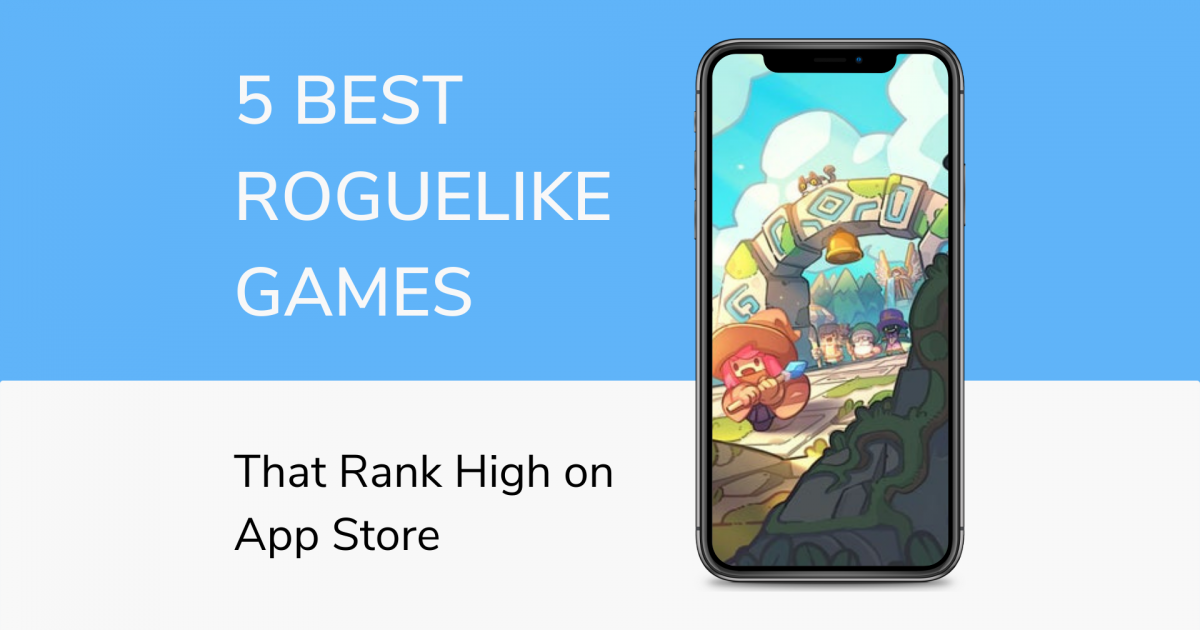
In order to get the best rank possible for an app, it’s essential to use competitive research tools. Without them, finding competitors’ keywords, which is what makes them rank better, becomes too challenging. However, it’s never too late to integrate ASO competitive research into your app ranking strategy!
Post Contents
What Is ASO Competitive Research?
ASO stands for App Store Optimization. Similar to SEO, ASO consists of a set of strategies that has the goal of improving mobiles’ applications’ visibility in app stores. This method relies heavily on the use of keywords so as to make one’s app more appealing to the platform’s algorithm.
Although one cannot control an app store’s algorithm, there are ways you can use it in your favor. Keywords are the main tool to do that. This means an app developer has to get acquainted with ASO competitive research if they want their application to succeed.
The Importance of Competitive Research Tools
ASO goes hand in hand with keyword competitor research tools. Tools like ASOTools let its users look through keywords’ popularity, ranking difficulty and niche, among many other relevant data. This information is a much-needed lead for apps to fare better in such a competitive market.
The more extensive the data gathered through ASO competitive research is, the clearer the optimization method becomes. Due to the fact that ASO hinges on factual data derived from a substantial investigation, tools that can provide detailed data are the best ones.
To give an example, if you were to rank for an app about equalizer, you’ll have to know how similar apps fare. In fact, seeing as trends greatly affects keywords’ performance, understanding the current craze is as important.
These facts provide you with a lot of information you can capitalize on. If there’s a trend, you can hop on the bandwagon and use that to your advantage. Should your type of app become more popular in certain countries, you know you must localize your app’s presentation and interface quickly.
Moreover, these tools should also be easy to use as finding competitors’ keywords and other data take a lot of time. Both ease of use and data gathering prowess are the top priorities of applications of that kind.
Is ASO the Same as SEO?
Although they both share the same goal: optimizing. Nonetheless, they are not synonyms.
SEO, which stands for search engine web optimization, is composed of a series of methods designed to increase one’s visibility in search engines. Inversely, ASO involves a group of techniques to raise one’s presence in app stores.
Thanks to the fact most people use two app stores, ASO is much more restrictive than SEO. All apps need to follow certain guidelines to stay in the store. Additionally, ASO is more visually-reliant while SEO has a few extra resources off-page to rank better.
Moreover, in SEO, web design also comes into play, which is a privilege apps will never have as they adapt to follow the stores’ interface. The whole app system is pretty constraining, so finding a way to be somewhat prosperous is definitely a foolish dream without using ASO competitive research tools.
How to do ASO Competitive Research?
Finding competitors’ keywords might be a bit too much to handle for newcomers in the field. Fortunately, ASOTools offers a great service for ASO competitive research. A quick rundown will serve to show how easy it is to utilize.
ASOTools for Keyword Research
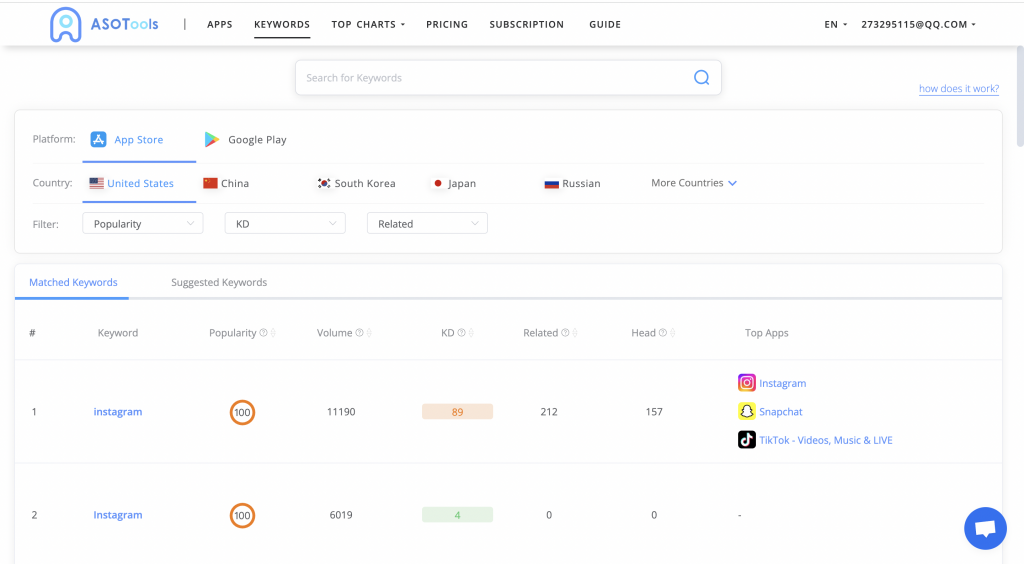
Like most tools for keyword research, ASOTools provide a search engine that displays the data of a given keyword. Within that data, there are important parameters to take into account.
You can look for competitors through region and store. On top of that, you can use filters to narrow down your research. A keyword’s difficulty to rank and its popularity are vital elements that one has to bear in mind when optimizing apps’ content.
Lastly, how related certain keywords are to the ones you’re looking for is also an important detail. Along with all of these features, you can check how apps fare with that keyword. Should I look for RPGs, ASOTool will present the top apps regarding that term.
Relevant statistics will be shown about those apps that will give a clear picture of their current status on an app store.
Filters
Filters are not only fancy features available in ASO competitive research tools. They play a very significant role in defining an ASO approach.
Popularity
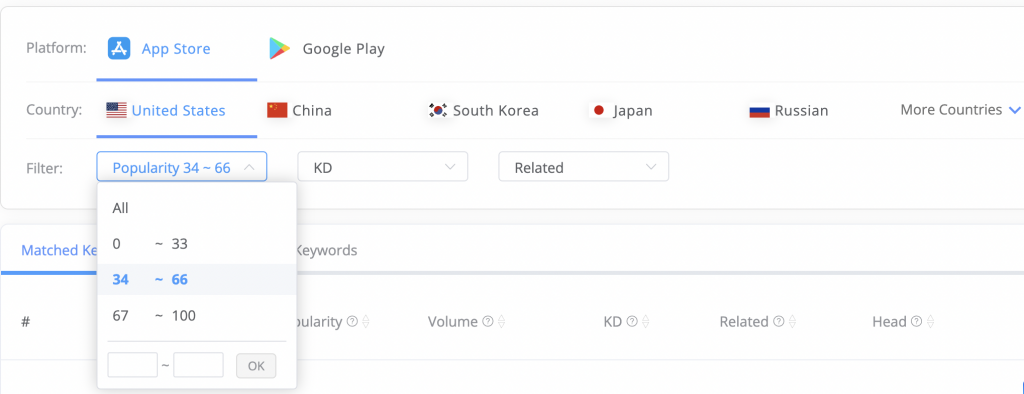
First, the popularity parameter shows how trendy a keyword or app is.
This should give an idea of the weight a keyword has. However, popularity is not always a good thing for app developers, especially when talking about ASO. Apps might even change their keyword focus if the popularity status does not fit with the apps’ ranking method.
Words with high-volume mean other apps have already taken over the keywords. Thus, ranking for them becomes extremely tough. Ranking high with those keywords is still achievable, but it might take some time and effort to step up the ladder until a comfortable rank range.
If going for a popular keyword is too much trouble, another option is to go for low-volume keywords. Many low-volume words can net you a lot of visibility, even rivaling big-name brands, if used efficiently.
The more diverse your range of opportunities, the better results you get from your ASO competitive research.
Keyword Difficulty
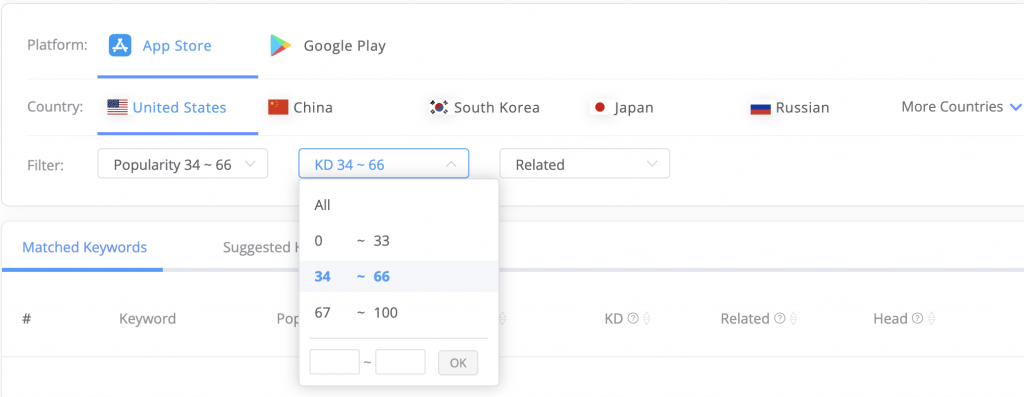
Furthermore, keyword difficulty, or KD, shows how competitive a keyword is.
Usually, high-volume keywords are extremely challenging to rank for– it’s not easy to be on top. Even if your app fits a keyword to the tee, you might want to consider a related keyword instead due to the competitiveness of your niche.
On the other hand, ranking for a set of keywords with low KD is often the go-to method for apps that don’t have much backup. In fact, some brands capitalize on new trends and plan their ASO strategy on non-competitive keywords.
Nevertheless, this doesn’t mean it’s a good idea to follow trends mindlessly. Quality content remains a must in every app display. It’s advisable to be updated on what’s all the rage recently in order to increase the odds of ranking higher.
Using KD in one’s favor should be considered along with other data derived from ASO competitive research.
Related Keywords

Going further, relevant keywords show how connected to your initial keyword others are. Masterfully using related keywords is what differentiates regular apps from top apps. One keyword is not enough, and developers should always look for other words they can rank for so as to stay competitive.
If keyword difficulty and popularity don’t match an app’s current needs, the developer team might as well go for another keyword instead. Naturally, the main keyword and theme of an app won’t get disregarded; rather, the related keywords will augment the ranking prowess of the main theme.
Mastering related keywords’ usage substantially boosts the potential of the root keyword. With them, previously uncontested apps might get thrown off for a loop over time. An app can slowly but surely reclaim great visibility built off an ASO strategy based on related keywords.
All three parameters work in tandem. The optimization process is incomplete if it ignores these filters. This is the true strength of ASO competitive research: in-depth knowledge of your competitors and your potential reach.
Tracking & Monitoring Competitors
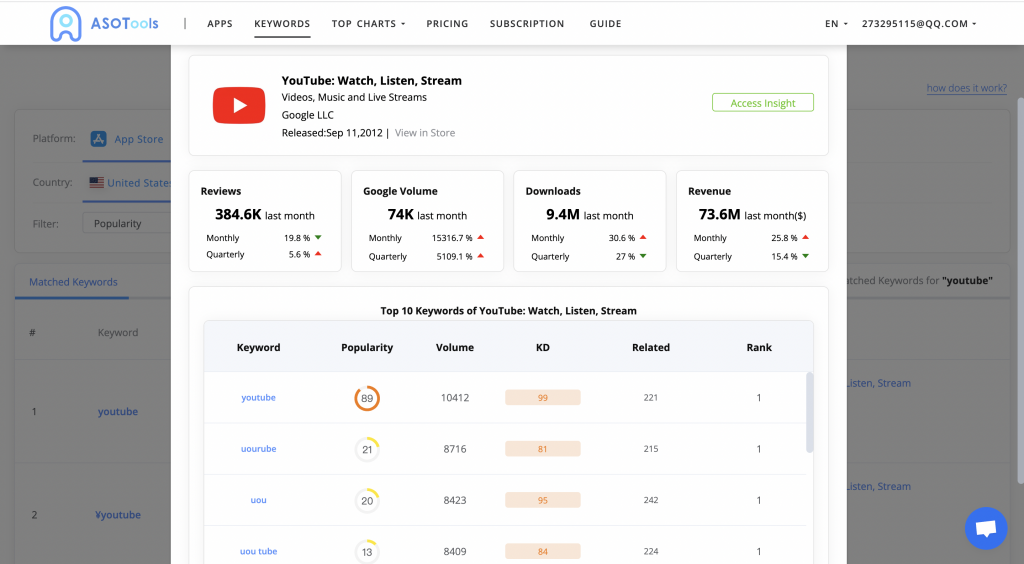
Despite the fact that keywords’ statistics carry a lot of value in them, they are not enough to decide on an ASO strategy. The success of competitors is another significant aspect to pay attention to.
By tracking competitors, one can see whether a keyword or niche is booming or flunking. ASOTools gather the revenue of most apps and recent changes in popularity. This reveals how profitable a keyword or niche is at the moment.
Moreover, you can use the tracker within the tool to see what makes your competitors shine. You can check the number of reviews, the search volume, downloads, revenue, and top keywords. These numbers are evaluated on a quarterly and monthly basis so as to determine recent performance.
Do mind that reviews and total downloads are key factors in ranking algorithms. Grasping how apps get them is a priority within ASO competitive research campaigns.
ASOTools for Revenue Research
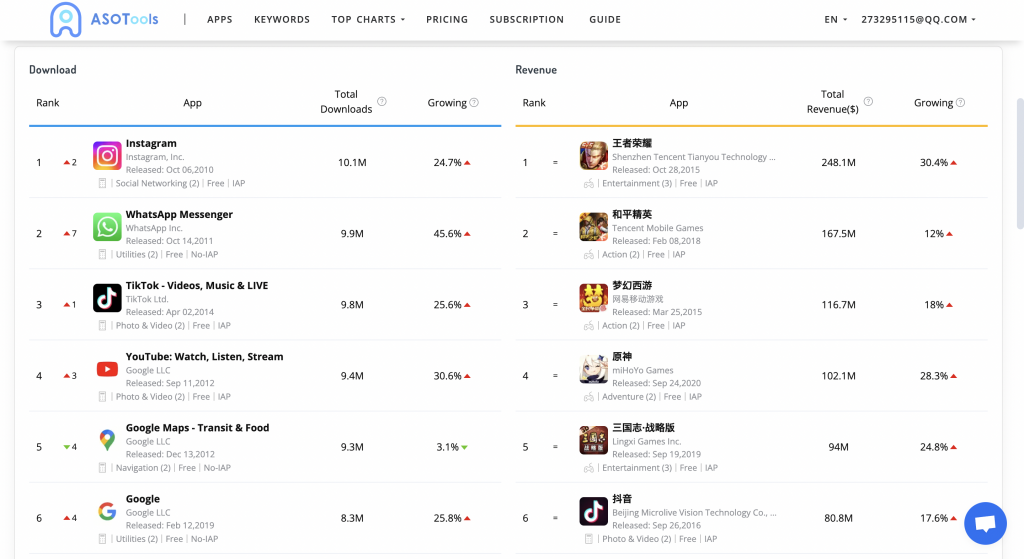
ASO competitive research doesn’t end just with keywords. One thing you can do to further refine your ASO strategy is to look through apps' top revenue charts in ASOTools.
The revenue is what ultimately shows the profitability of keywords and app genre. What’s more, it’s possible to scan pre-launch revenue, which is truly useful in learning ASO for yet-to-launch apps. This tool has a few filters to boot, too.
For example, one can explore apps per category or free and paid apps. Lastly, there’s a filter that presents a database based on the average revenue apps had in the last months. The option is perfect for studying consistently successful apps over time, up to a year.
Revenue as Proof
Revenue and total downloads are directly linked to the commercial success of apps. Needless to say, this is a byproduct of their visibility.
Revenue represents the amount of money an app is officially making regardless of the method. Regardless, revenue does not represent popularity or total downloads. For example, social media platforms never make it into the top apps with the highest revenues.
Alternatively, gacha games hold gigantic monetary games, but not the popularity expected from their revenue. ASO competitive research puts into perspective that a certain amount of visibility is enough to triumph economically.
In the end, revenue research is part of researching competitors’ success while partaking in the ever-so vital market research.
What to Do With ASO Competitive Research Data?

Now that going through the systematic process of ASO, it’s time to apply all those readings to an ASO strategy. Then, one has to ponder what exactly the ASO process entails.
Descriptions
Descriptions are short and seemingly simple to write, but nothing could be further from the truth. Learning how to write a description requires training and flexible thinking.
There are a number of questions one should ask before writing a description: ‘What does this app offer? What is the target audience looking for? What would make readers trust in them?’ Queries like these should be answered as shortly as possible.
Additionally, most users will scroll down through lengthy descriptions. For the sake of both improving the readers’ experience and getting your description across, it’s key that everything is short and simple. ASO competitive research proves long descriptions affect an app’s visibility negatively.
Not only that, but the description must be understandable for potential readers. Specific terminologies and lexicon that only a few share won’t do any good to your description. The more global a description is, the more readers it gets.
Lastly, globalization vastly impacts ASO practices. Potential users can be pretty much anywhere in the world. To make the best out of that premise, localizing description is a necessity for any mobile application.
Videos
Youtube has undoubtedly shown the power videos have in today’s world. In fact, people tend to stay on a site if there are videos on it.
Videos are such a strong asset because the audience acquires a lot of information in a short span of time. Meanwhile, brands can display their product in a matter of seconds. Both parties greatly benefit from how expressive video clips are.
The same logic applies to the app’s optimization. App stores offer a feature to include a video. This video should include footage that is concise and shows the main strengths of an app in about seconds. Generally, the keywords and the app’s nature dictate what the video should be about.
It’s worth mentioning that convincing videos make use of a combination of skills to be developed. For instance, not only is ASO competitive research taken into account, but also graphic design and traditional marketing strategies.
Screenshots
Screenshots are great for encouraging audience engagement, but they are quite complex to use. These pictures must follow a strict screenshot guideline while still enticing potential users..
For example, games fare better with full-page screenshots as users want to see the gameplay as it is. But for functionality apps, a custom screenshot might be more advisable so as to show how to use the features in them. The pictures must match the app.
Also, your competitors’ use of screenshots comes in handy. ASO competitive research is truly useful in this aspect thanks to the inspiration you can take from top apps. In them, you can see the priority and style screenshots displayed.
Analyzing the usage given to screenshots is a legitimate strategy that can work wonders in gaining visibility. There are many statistics in regard to screenshots. The overall conclusion is that using them properly nets more visibility, but misuse affects apps negatively.
Icons
Icon design is the most essential graphic design in an app. This is the first element potential users get to see. Icons need to be aesthetically pleasing and reveal what your app is about.
The first impression an app ever leaves is through icons. They are the first interaction audiences have with your product. Hence, it’s a necessity to design a good one for people to see. These little images need to be unique and very telling about an app’s theme.
That’s not to say descriptions are irrelevant in the presence of a good-looking icon. On the contrary, descriptions and other visuals re-ignite the interest an icon gives off. Nevertheless, it is true that without charming icons, other ASO techniques suffer greatly.
Thanks to the excessive amount of mobile applications in the market, icons need to stand out for themselves. With ASO competitive research, apps’ icons can be looked upon to dissect what makes a great icon and how to derive from it.
Competitors should be used for inspiration, but not for plagiarism. Very alike icons will, without a shadow of a doubt, mark an app as the rip-off of the more popular version. Even though it may net quite the visibility at first, it’s more hurtful than helpful: the reputation of an app drops considerably
The A/B Test
Having the ASO competitive research already done, it’s time to put the results to the test.
The A/B test consists of publishing two or more versions of an app’s presence in different media. These are customized in accordance with the data keywords competitors’ research exhibited. The idea is to compare how each version did.
This technique is nothing out of the ordinary and that’s what makes it special. Despite the years, it’s been used already, it remains simple and effective. The test lets a company find the strengths and weaknesses an app has for it to improve.
To give an example, the A/B test can be used to determine how effective a video is for your app. Picking up leads from dissimilar platforms comes in handy when trying to go for both stores. Each app marketplace values keywords in its own way, which is why ASO strategies should adapt to them.
Ranking for App Store vs Ranking for Google Play
Since there are only two platforms ASO competitive research is used for, understanding how to rank for each of them is crucial.
The Stores’ Algorithms
The way each platform indexes apps and their keywords are poles apart. Thus, how to manipulate the stores’ algorithm changes significantly.
Regarding Apple’s store, the algorithm is more veered toward images and short texts. The search engine of the App store displays one to three preview videos and two screenshots. As such, the app’s optimization should be centered around visual engagement.
Even images do affect visibility. Keywords, of course, are still an important element, but they are not the only major player in the ranking of apps. The store’s algorithm goes as far as not viewing an app’s description as a visibility tool; instead, it’s an engagement lead.
In the case of Google Play, the app takes into account a lot more factors for positioning. The algorithm examines every textual information in apps’ displays. As a matter of fact, even the amount of backlinks your app website has is considered a ranking aspect.
Moreover, Google Play does not see visual engagement as a visibility factor. Regardless, it does encourage users’ engagement. All in all, the Google Play store’s optimization seems to benefit the most from ASO competitive research.
Text Display
Both stores offer unalike layouts to describe their apps. Even the keywords inside them influence visibility quite a lot.
iOS store does not use tags nor does it perceive long descriptions as visibility enhancers. Yet, they are indispensable to incite users to check applications out. That’s why text information about them has shorter word limits.
Apart from the long description, the app name, short description, and promotional text augment the images' charm. As for Google Play, this works around in the opposite direction, making images just a bonus asset for extra engagement.
The latter store places serious value on app names and both descriptions. For its algorithm, these are key entries that let its users discover what the app is about. Thus, an ASO strategy leaning towards these layouts is of utmost importance.
Despite all these differences, it’s worth noting that both stores benefit from extensive ASO competitive research. Google play leans towards keywords’ algorithm whilst App Store gambles on user engagement.
Conclusion
It’s a must to check competitors’ keywords. Without knowing how keywords perform or what competitors use, going for the top ranks is out of the question. ASO competitive research is far too necessary for any app developer or marketer.
Luckily, ASOTools, one of the best tools for keyword research, can help you with that. The tool can help find you any keyword or competitor related to your app’s niche. On top of that, the statistics display makes deciding on an ASO approach much easier.
With ASOTools, you can start optimizing your app’s visibility right away!
Boost Your App's Downloads & Revenue!
Gain data and insight to make your decisions right with all-in-one ASOTools!
99% OFF on Basic/PRO Plans


